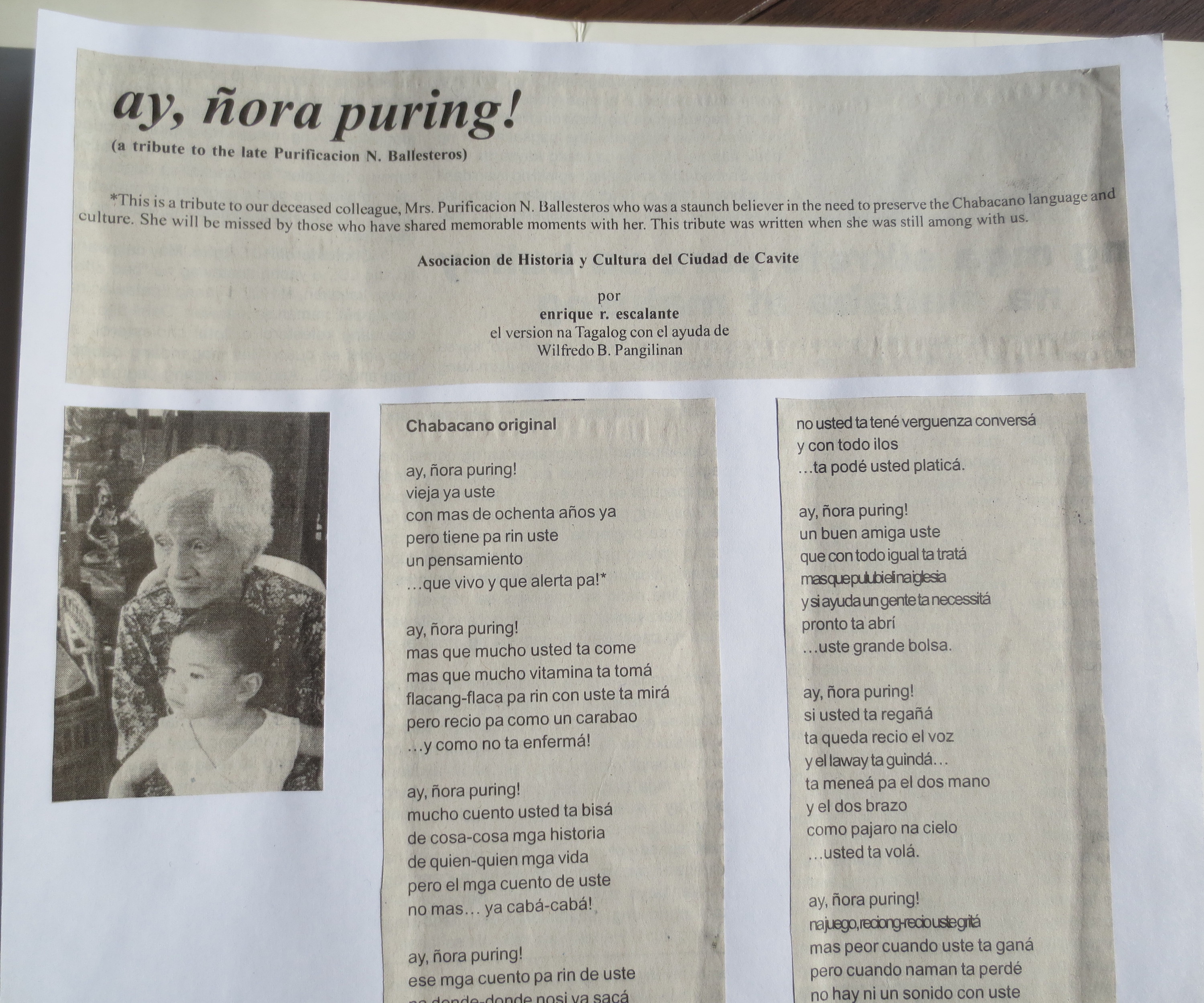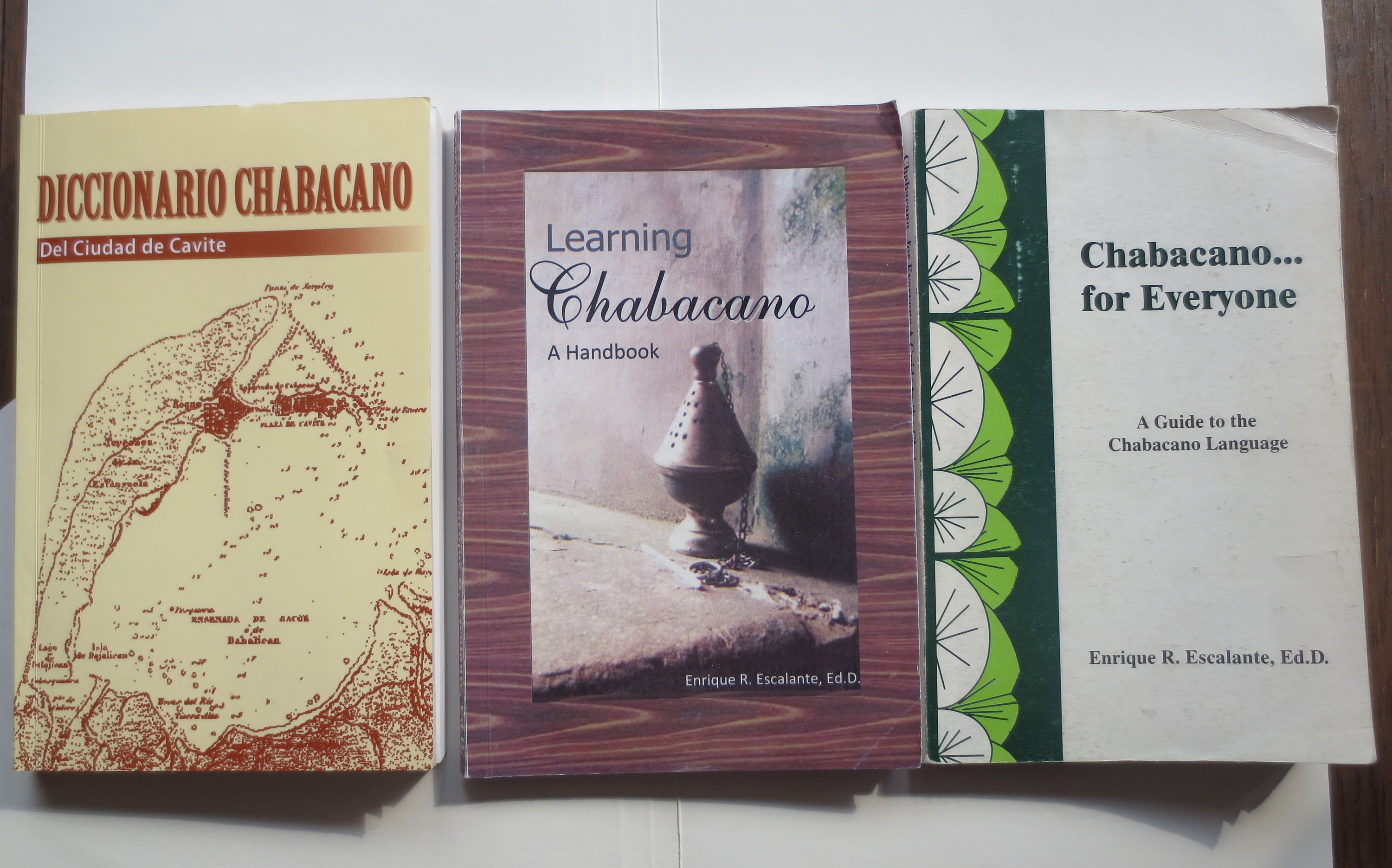「 タガログ語、タグリッシュ、英語そしてチャバカノ語
− カオスの中のアイデンティティー −」 (4/4ページ)
荻原 寛(長崎県立大学名誉教授)
3.5.3 チャバカノ語復興運動の顛末
筆者が92年から99年まで断続的に行ったフィールドワークを支え、様々な人脈を開拓して下さり、貴重な資料を集めて下さった人物は、チャバカノ語話者で元小学校教員のプリフィカシオン・バリェステロスPurificacion Ballesteros老夫人であった。父親がカビテ市出身の著名なチャバカノ語の詩人、エリオドロ・バリェステロスEliodoro Ballesterosであるだけでなく、ご自身の社交的な性格から幅広い人脈を持ち、町の誰からも「ニョラ・プリン」Ñora Puring(プリンおばさん)と慕われていた。夫人は熱心なチャバカノ語普及運動家であり、最初に引き合わされたのがチャバカノ語研究家のエンリケR.エスカランテE.R.Escalante氏であった。2007年に研究とは別にフィリピンを訪れる機会があり、ニョラ・プリンを初め研究に協力してくれた人々のもとを挨拶して回った。その折に、エスカランテ氏は2年前に出版したというチャバカノ語に関する本を下さり、次作の草稿を見せながら熱心に構想を語ったいた。それから9年の月日が流れ、今回再びカビテとテルナテを訪れることとなったが、その間に、ニョラ・プリンは鬼籍に入り、その家族とも次第に連絡が取れなくなっていた。エスカランテ氏とはたまにメールのやり取りをしたが、2013年頃から返信が来なくなり心配していたが、今回の調査で2014年に氏も鬼籍に入っていたのを初めて知ったのである。
久しぶりに現地調査をして見えてきたことは、Lesho and Sippola (2013) が出たころを境に、カビテ語もテルナテ語も民間の大きな推進力を次々に失ったという厳しい現実であった。その意味で、二人の長年にわたる現地での調査研究の集大成は、滅びゆくマニラ湾沿岸部のチャバカノ語への最後のオマージュであり、残照の輝きを言語史の一頁に留めた功績は極めて大きいと言える。ニョラ・プリンは、カビテ市内の様々なカビテ語復興運動家たちの橋渡し役として、老齢とは思えない縦横無尽の活躍をし、リプスキをはじめ世界各地から研究者がフィールドワークに訪れたときは、有能なアテンダント役として心から調査を支えた。ニョラ・プリンとは母親の代からの親しい友人であるエスカランテ氏は、カビテ語入門書1冊と用例と簡単な文法解説付きのチャバカノ語辞書1冊を出版し、地方紙Operation Exposéに毎週チャバカノ語のコラムを寄稿するなどの文筆活動のほかに、民間のチャバカノ語保護育成運動団体であるカビテ市チャバカノ語協会Asociacion Chabacano del Ciudad de Caviteの一員として活躍し、チャバカノ語の語学学校であるエスクエラ・チャバカノEscuela Chabacanoまで創設した。[18]チャバカノ語教育におけるエスカランテ氏の先駆者は、元小学校教員のノルマ・カストル・ベルサベNorma Cástor Bersabe女史であった。女史は手書きやタイプで打ったカビテ語の教科書を数冊作り、希望者を募っては洋裁学校の一隅を借りてカビテ語教室を開いていた。女史もまたニョラ・プリンの親しい友人だったが、物故して10年以上になる。21世紀に入って一時勢いのあったカビテ語復興運動の一環として、地元のマヌエル・ロハスManuel Rojas小学校で成人だけを相手にカビテ語教室を開いていた元小学校教員のソレダー・サンタ・アナSoledad Santa Ana女史が使っていたのも、ベルサベ女史が残した手作りの教科書だった。出版関係で忘れてはならないのは、同じくニョラ・プリンの年来の友人であるデラ・ロサdela Rosa夫妻の存在である。夫のホセ・デラ・ロサJose dela Rosa氏はカビテ市チャバカノ語協会会長の経歴を持ち、協会から編者数名と一緒にチャバカノ語辞典を出版した。今回の調査でも惜しみない協力をしてくださり、氏の発話も映像を含めて収録することができた。妻のジョスリン・デラ・ロサJocelyn dela Rosa女史はカビテ市立図書館長を長年務め、在職中に図書館のウェブサイトを立ち上げて、2003年から2010年までアビソAvisoというメールマガジンを発信し、毎号必ずチャバカノ語のコラムを載せては言語の広報に努めた。夫妻は存命であるが、復興運動からはすでに退いてしまっている。
他方、テルナテ語の復興を推進してきたのは、テルナテの町はずれにあるカビテ・ウエスト・ポイント・カレッジCavite West Point Collegeの校長、エバンヘリーノ・ニゴサEvangelino. Nigoza氏である。テルナテ語の研究家であり論文や著書もある氏は、バランガイの中心人物であり、その求心力は往時は非常に大きかった。残念ながら脳梗塞で倒れてからは発話に障害を持つに至り、以前のような精力的な活動は影を潜めてしまった。しかしながら、現職にあり、周囲には常に人が集まるカリスマ的存在なので、氏を主催者とし、弟子たちが幹部を務めるテルナテ語の保護育成団体、シルコロ・デ・マルディカスDircolo de Mardicasを介して復興運動は継続されていくものと思われる。因みに、彼らはテルナテ語の呼称をスペイン語のテルナテーニョternateñoではなく、土地の呼び方であるバーラBahraと呼ぶことを主唱している。
--------------------------------------------------------
[18] 2017年10月現在、この学校は閉校となっている。
 拡大する
拡大する
エスカランテ氏がニョラ・プリンに捧げたカビテ語で書かれた哀悼の頌歌

右と中央:エスカランテ氏の入門書 左:カビテ市チャバカノ語協会編の辞書
 拡大する
拡大する
ベルサベ女史の手作りのカビテ語教科書。左は手書き、右はタイプライターによる。
4.結び
フィリピンでは、多くの国内少数言語が存続の危機を迎え、すでに消滅して死語となった言語も少なからずある。まさにその瀬戸際にあるのが、マニラ湾沿岸部のチャバカノ語であるカビテ語とテルナテ語である。1957年にフィリピン政府が、土着言語で授業を行うのは、タガログ語と英語のバイリンガルによる教育への過渡的橋渡しとしてであって、小学校の1年生と2年生に限ると制定して以来[19]、まだ必修科目だったスペイン語を除くその他の国内の言語への風当たりが強まったからである。
そうした中、弱小言語にわずかに希望の光が差し込んだ。2001年に当時の教育文化スポーツ省長官が制定した、フィリピノ語教育と英語教育よりも前に、各地の土着言語のlingua francaを用いて識字能力を高める制度である。[20]このおかげで、例えば2012年度は「母語に基づく多言語教育」(MTB-MLE:Mother Toung Based-Multi-lingual Education)プログラムにより、タガログ語だけでなく、カンパンパンガン語、パナガシナン語、イロカノ語、ビコール語、セブ(ビサヤ)語、ヒリガイノン語、ワライ語、タウスグ語、マギンダナオ語、サンボアンガ語の11の土着言語による教育が、幼稚園から小学校3学年まで全国で実施されたのである。[21]
それにもかかわらず、カビテ市では、今まで復興運動に熱心に取り組んできたチャバカノ語の母語話者が次々と舞台を去ろうとしている。彼らのリアルな運動に代わるものとして、インターネットのホームページ、ブログ、Youtube、フェイスブックなどを利用して、動画を発信するヴァーチャルな方法がある。ただし、こうしたアプリケーションには大きな弱点があり、事態を難しくしている。よほど頻繁にアクセスしない限り、GoogleやYahooなどでは遥か後ろのページに追いやられてしまうのである。特に動画は短命で、実際に、2年前までは簡単にアクセスできた故エスカランテ氏の作成したチャバカノ語動画はすでに消去されている。
言語は日々使われる領域を失うと死滅する。しかし、死語への道を辿り始めている言語も社会的な力を持つことがある。その言語がアイデンティティーのよすがとして意識された時である。遠い先祖から代々受け継がれてきた言語が目の前で死にかけており、自分にはすでにその言語の運用能力がない状態の中で、その言語が次代に継承されるように努力するか否かは、頗る文化的な問題である。行政からの支援があったとしても、いわば「容器」であり、そこに容れる「コンテンツ」は支援を受ける者が選ばなければならない。未だ命ある言語を過去の遺物として博物館のように展示するのか、それとも水族館や動物園のように命ある存在として扱って来訪者を取り込むのか、その言語の母語話者に限らず、言語が育まれてきた地域に住む住民一人一人が、アイデンティティーをキーワードに考えるべきテーマである。そのヒントともなろうものが、地元カビテ市のマクドナルドのトイレのドアにあった。カビテ語で書かれた「男」と「女」であるが、単に目で読む文字ではなく、発音記号が付いている。声に出して読むとき、言語は受動から能動へと切り替わる。
左側が「女性用」で右側が「男性用」。英語とカビテ語で併記し、それぞれに
発音記号に似せた ものが付してある。(2016 年 10 月 25 日 Cavite City の McDonald’s にて筆者が撮影)
----------------------------------------------------------
[19] Anderson and Anderson (2007:128)
[20] Decker and Young (2005: 197)
[21] DepEd order no.16, s.2012.
【参考文献】
Alic Go, Mikhail and Gustilo, Leah (2013). “Tagalog or English: the Lingua Franca of Filipino Urban Factory Workers”, Philippine ESL Journal, Vol, 10., ELE Publishing, pp.57-87.
Anderson, Victoria B. and James N. Anderson. (2007). “Pangasinan—An Endangered Language? Retrospect and Prospect”, Philippine Studies , 55(1), University of Hawaii, pp.116–144.
Asociacion Chabacano del Ciudad de Cavite (2008). Diccionario Chabacano, the Office of the City Mayor, Cvite City.
Bautista, Maria Lourdes S. (2004). “Tagalog-English Code Switching as a Mode of Discourse”, Asia Pacific Education Review, Vol. 5, No.2, 226-233.
Crystal, David (2000). Language Death, Cambridge University Press, Cambridge.
Cubar, Nelly I. and Cubar, Ernesto H. (1994). Writing Filipino Grammar: Traditions &Trends, New Day, Quezon City.
Dayag, Danilo T. (2012). “Philippine English”, in E-L Low and A. Hashim (rds.): English in Southeast Asia -Features, policy and language in use-, John Benjamins Publishing Company, pp.91-99..
Dekker, Diane and Catherine Young. (2005). ” Bridging the gap: The development of appropriate educational strategies for minority language communities in the Philippines”. Current Issues in Language Planning 6 (2)., Routledge, pp.182–199.
Department of Education, Republic of the Philippines (2012). “Guidelines of the implementation of the Mother Tongue-Based-Multilingual Education (MTB-MLE)”. DepEd order no.16, s.2012. http://www.deped.gov.ph/orders/do-16-s-2012
Escalante, Enrique R. (2005). Chabacano…for Everyone-A Guide to the Chabacano Language, Baby Dragon Printing Press, Manila.
--------- (2010). Learning Chabacano - A Handbook-, Baby Dragon Printing Press, Manila.
Frake, Charles O. (1971). “Lexical Origins and Semantic Structure in Philippine Creole Spanish”, Pidgignization and Creolization of Languages, Dell Hymes, pp.223-242.
García Louapre, Pilar (1990). El idioma español en Filipinas desde la conquista a nuestros días, Editor S.A., Madrid.
German, Alfredo B. (1932). “The Spanish Dialect of Cavite”, Master‘s Thesis, University of the Philippines.
Gonzalez, Andrew (1997) . “The history of English in the Philippines”, in Bautista, M.L. (ed.) English is an Asian Language: The Philippine Context, Macquarie Library, ppp.25-40
--------- (1998).” The Language Planning Situation in the Philippines,” Journal of Multilingual and Multicultural Development, Vol.19, No.5&6, Routledge, pp.487-525.
--------- (2003). ” Languagec planning in multilingual ccountries: The case of the Philippines”,Conference on Development Language Revitalization and Mutlilingual Education in Minority in Asia, SIL, Bangkok. http:// www-01. sil. org/ asia/ ldc/ plenary_papers / andrew_gonzales.pdf
Grant, Anthony (2013). “On the (dis)unity of the Manila Bay Creoles: some lexical strata in Ternateño”, Revista de Crioiulos de Base Lexical Portuguesa e Espanhola, 4, Associação de Crioulos de Base Lexical Portuguesa e Espanhola, pp.26-47
Holm, John (2001). “Chabacano versus related creoles: Socio-linguistic Affinities and Differences”, Estudios de sociolingüística: Linguas, sociedades e culturas, Universidade de Vigo, pp.69-94.
和泉模久(1982). 『フィリピン語入門』、泰流社。
Jones, M. (2004). “ Some structural and social correlates of single word intrasentential code-switching”, French Language Studies, 15, Cambridge University Press, pp.1-23.
Kirkpatrick, Andy (2007). World Englishes: Implications for international communication and English language teaching, Cambridge University Press.
小張順弘 (2004). 「フィリピン多言語社会での言語とアイデンティティ‐セブアノ多言語話者の事例から」、『言葉とアイデンティティ』、三元社。
Lesho, Marivic (2013). “The Sociophonetics and Phonology of the Cavite Chabacano Vowel System”, dissertation, Ohio State University.
Lesho, Marivic and Sippola, Eeva (2013). “The Sociolinguistic Situation of the Manila Bay Chabacano-Speaking Communities”, Language Documentation & Conservation, Vol.7, University of Hawaii, pp.1-30. http://hdl.handle.net/10125/4547
--------- (2014). “ Folk Perceptions of Variation among the Chabacano Creoles”, Revista de Crioulos de Base Lexical Portuguesa e Espanhola, 5, Associação de Crioulos de Base Lexical Portuguesa e Espanhola,pp1.-46.
http://www.acblpe.com/revista/volume-5-2014/folk-perceptions-of-variation-among-the-chabacano-creoles
Linangan ng mga Wika sa Pilipinas, etc. (1989). Diksyunaryo ng Wikang Filipino, Unang Edisyon, National Bookstore.
Lipski, John M.(1985). “Creole Spanish and Vestigial Spanish: Evolutionary Pararelles”, Linguistics, 23, Mouton de Gruyter, pp.963-984.
--------- (1987a). “Descriolización del criollo hispanofilipino´el caso de Zamboanga”, Revista Española de Lingüística, pp.37-56.
--------- (1987b). “Modern Spanish Once Removed in Philippine Creole Spanish: The case of Zamboangueño”, Language in Society, 16, Cambridge University Press , pp.91-108.
--------- (1992a). “New Thoughts on the Origines of Zamboangueño”, Language Sciences, 14-3, Elsevier, pp.197-231.
--------- (1992b). “Origin and Development of ‘ta’ in Afro-Hispanic Creoles”, Atlantic meets Pacific, Creole Language Library, 11, John Benjamins, Amsterdam , pp.217-231.
-------- (2001a).”Chabacano/Spanish and the Philippine Linguistic Identity”, About the Philippines, unpublished. https://aboutphilippines.ph/documents-etc/chabacano[1].pdf
-------- (2001b).”The Place of Chabacano in the Philippines Linguistic Profile”, Estudios de Socio-lingüística, Universidade de Vigo, pp.119-163.
-------- (2002). “When does ‘Spanish’ become ‘creole’ and vice versa? : the case of Chabacano (Philippine Creole Spanish)”, Colloquium on Hispanic and Luso-Brazilian Literatures and Romance Linguistics: Austin: University of Texas, unpublished.
http://www.personal.psu.edu/jml34/Chabacano.PDF
--------- (2003). “SpanishWorld-wide : the Last Century of Language Contacts”, invited lecture at Middlebury College, March 6. http://www.personal.psu.edu/jml34/sww.pdf
--------- (2009), “Philippine creole Spanish: assessing the Portuguese element”, Zeitschrift für romanische Philologie, 104(1-2), De Gruyter Mouton, pp.25-45.
Llamado, Librada C. (1972). “The Phrase-Structure Rules of Cavite Chavacano”, Philippine Journal of Linguistics, 3, Linguistic Society of the Philippines.
Lorenzino, Gerardo A. (1993). “African vs. Austronesian Substrate Influence on the Spanish-based Creoles”, Atlantic Meets Pacific, Creole Language Library, 11,
John Benjamins, Amsterdam.
--------- (2000). The Morphosyntax of Spanish-lexified Creoles, LINCOM Studies in
Pidgin & Creole Linguistics, 2, Maruzen, Tokyo.
Marasigan, Elizabeth (1983). Code-Switching and Code-Mixing in Multilingual Societies, Singapore
Martin, Isabel Pefianco (2010). “Periphery ELT: the politics and practice of teaching English in the Philippines, in A. Kirkpatrick (ed.) The Routledge Handbook of World Englishes, Routledge, pp.247-264.
Mckaughan, Howard (1954). “Notes on Chabacano grammar”, Journal of East Asiatic Studies 3, pp.205-226.
Mercado, K. A. (2010). “A descriptive study on code-switching among grade 6 math and science teachers‘ utterances”, Master‘s Thesis,.De La Salle University, Manila.
Metila, Romylyn A. (2009). “Decoding the Switch: The Function of Codeswitching in the Class-room”, Education Quorterly, vol.67 (1), University of Philippines College of Education, pp.44-61.
Miranda, Gervasio (1956). El Dialecto Chabacano de Cavite, unedited, Ciudad de Dumaguete, Negros Oriental
Muysken, Pieter (2000). Bilingual Speech: A Typology of Code-Switching, Cambtidge University.
Nigoza, Evangelino (2007). Bahra. The history, legends, customs and traditions of Ternate, Cavite Hostorical Society.
大上正直(1994). 『フィリピノ語文法入門』、白水社。
荻原寛 (1994a).「フィリピンのスペイン語系クレオール、カビテ語における性数概念」、『長崎県立大学論集』第27巻第2・3号、長崎県立大学学術研究会、pp.479-96.
--------- (1994b).「マニラにおけるスペイン語話者の現状について」、『調査と研究』、第25巻第1号、長崎県立大学国際文化経済研究所、pp.107-20.
--------- (1995).「マニラ湾沿岸部のスペイン語系クレオールをめぐって-アスペクトとフ
ォーカスを中心に」、Hispánica 39、日本イスパニヤ学会、pp.114-28.
--------- (1996).「カビテにおけるスペイン語系クレオール話者の現状について」、『調査と研究』、第27巻第1号、長崎県立大学国際文化経済研究所、pp.1-18.
--------- (1999).「マニラ湾沿岸部のスペイン語系クレオールの語順をめぐって」、『長崎県立大学論集』第33巻第2号、長崎県立大学学術研究会、pp.161-90.
Ogiwara, Yutaka (2002). “Aparición del sustrato en el predicado del caviteño”, Papia, No.12, Associação Brasileira de Estudios Crioulos e Similares, Universidade de Brasília, pp.67-83.
小野原信義 (2004). 「アイデンティティ詩論‐フィリピンの言語意識調査から」、小野原信義+大原始子(編著)『言葉とアイデンティティ』、三元社。
Pámparo Ramos, María Lourdes (1993). “La lexicografía bilíngüe filipina durante la primera etapa de la colonización española (1521-1663)”, Actas del tercer congreso de hispanistas de Asia,Asociación Asiática de Hispanistas, Tokio, 1993, pp.316-317.
Pérez, Mariola (2015). “Cavite Chabacano Philippine Creole Spanish: Description and Typology”, dissertation at University of California.
Poplack, S. (1980). “Sometimes I'll start a sentence in English y termino en español”. Linguistics,18, Mouton de Gruyter, pp.581-618.
Quilis, Antonio (1992) La lengua española en cuatro mundos, MAPFRE, Madrid.
----------- (1995) . “ El español en Filipinas”, C. Silva-Corvalán (ed.), Spanish in Four Continents, Georgetown University Press. pp.293-301.
Romanillos, Emmanuel Luis A. (1996). “Rizal and Chabacano”, Five Stories of Chabacano, University of the Philippines.pp.1-17.
----------- (1999). Cantos folklóricos y poesías de Cavite en chabacano y español, Universidad de Filipinas-Dilimán, Ciudad de Quezon.
----------- (2006). Chabacano Studies -Essays on Cavite’s Chabacano Language and Literature -, Cavite Historical Society.
Santos, Vito C. (1978). Vicassan’s Pilipino-English Dictionary, Revised Edition, National Bookstore.
Schachter, Paul & Otanes, Fe T. (1972). Tagalog Reference Grammar, University of California Press.
芝田征二 (1990). 「第7章 フィリピンの英語」、本田信行編『アジアの英語』、くろしお出版。
Sibayan, Bonifacio P. (1978). “Views on language and identity: Limited Metro Manila example.”, in A.Yap (ed.) Language Education in Multilingual Societies, Singapore University.
----------- (1994). “The role and status of English vis-à-vis Filipino and other
languages in the Philippines”, in T. Kandiah and J. Kwan-Terry (eds.) English
and Language Planning: A Southeast Asian Contribution, Times Academic Press, pp.218-41.
Sippola, Eeva (2011). Una gramática descriptiva del chabacano de Ternate, tesis doctoral, Unigrafia, Helsinki.
Steinkrüger, Patrick O (2008). “The Puzzling Case of Chabacano: Creolization, Substrate, Mixing and Second Contact”, Studies in Philippine Languages and Cultures, vol. 19. pp.142-157.
Thompson, Roger M. (2003). Filipino English and Taglish, John, Benjamins Publishing Company.
Tirona, Tomás T. (1924). “An Account of the Ternate Dialect (of Cavite P.I.)”, Tagalog Paper 487 of the Beyer's Collection, Philippine National Library,
UNESCO (2003). Language vitality and endangerment. UNESCO Intangible Cultural Heritage Unit’s Ad Hoc Expert Group on Endangered Languages. Approved 31 March 2003 by the Participants of the at International Expert Meeting on UNESCO Programme Safeguarding of Endangered Languages, UNESCO, Paris-Fontenoy, 10-12 March 2003.
Whinnom, Keith (1956). Spanish contact vernaculars in the Philippine Islands. Hong Kong University Press.
Zirker K. A. (2007).” Intrasentential vs. intersentential code switching in early and late bilinguals”, Master‘s Thesis, Bringham Young University, Provo.






